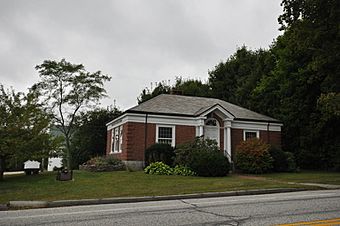Limington Historic District facts for kids
Quick facts for kids |
|
|
Limington Historic District
|
|

The library
|
|
| Lua error in Module:Location_map at line 420: attempt to index field 'wikibase' (a nil value). | |
| Location | Jct. of ME 11 and ME 117, Limington, Maine |
|---|---|
| Area | 60 acres (24 ha) |
| Built | 1790 |
| Architect | John Calvin Stevens, John Howard Stevens |
| Architectural style | Federal, Gothic Revival |
| NRHP reference No. | 98001601 |
| Added to NRHP | January 15, 1999 |
The Limington Historic District is a special area in the heart of Limington, Maine. It's like a time capsule, showing what a rural village looked like long ago. This district is found where Maine State Routes 11 and 117 meet. It includes 24 old buildings that were built between the late 1700s and the mid-1800s. Because these buildings are so important to history, the district was added to the National Register of Historic Places in 1999.
Discovering Limington's Historic Village
The town of Limington is in northern York County. People first settled here in the 1770s. The village center grew where four large land properties met. These properties belonged to the first owners of the town.
One owner, Thaddeus Richardson, gave land for the Congregational church. The church building you see today was built in 1835. It has a style called Greek Revival. Another owner, Philemon Libby, had land to the northwest. His house, built around 1794, is still standing today.
Ephraim Clark owned the southeast corner. He gave land for the town's animal pound. Today, the town hall, built in 1871, stands roughly in that spot. The Chick family owned the southwest property. This is where the town library is now. The library was designed in 1912 by famous architects John Calvin Stevens and his son John Howard Stevens.
What Kinds of Buildings Are There?
Most of the buildings in the Limington Historic District are homes. They are usually made of wood. They are either 1-1/2 or 2-1/2 stories tall. Many of them show styles like Federal or Greek Revival.
One interesting home is the Moody House, built around 1860. It has Italianate style brackets, which are decorative supports under the roof. Two buildings that were once stores are now used as homes.
Other important buildings include the Masonic hall, built in 1818. It stands where Philemon Libby once had a store. There is also the Grange hall, built around 1864. This building was first used as a small clothing factory.

